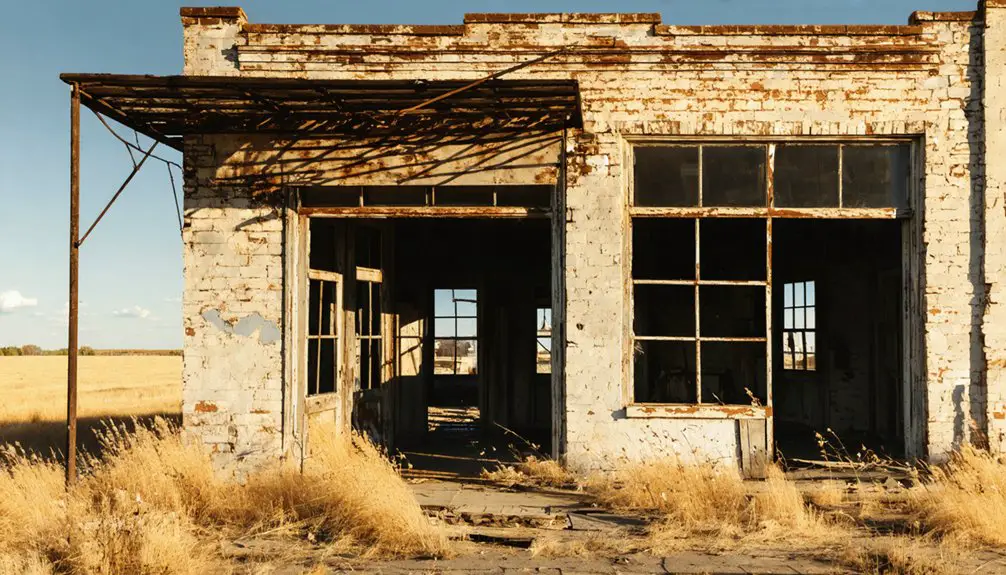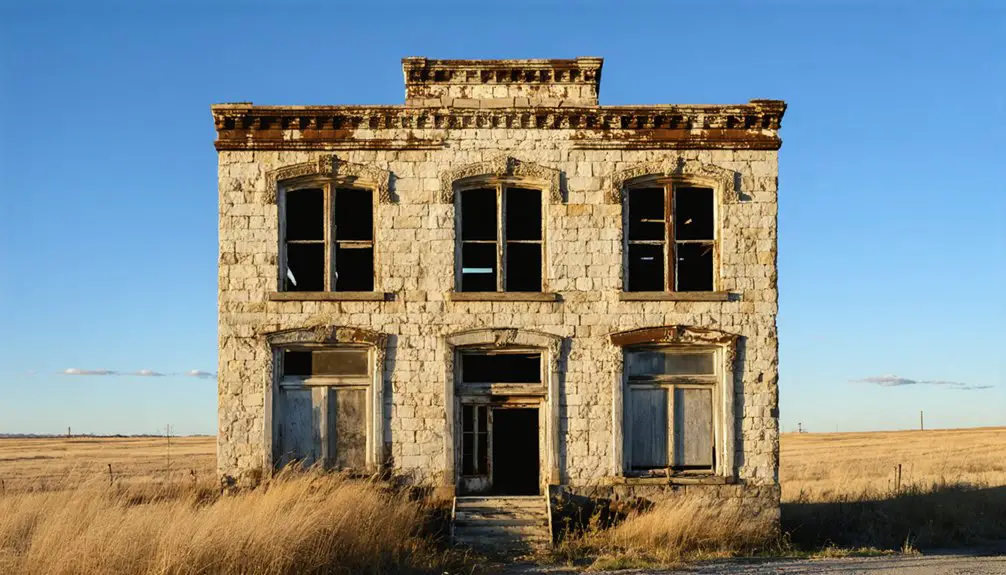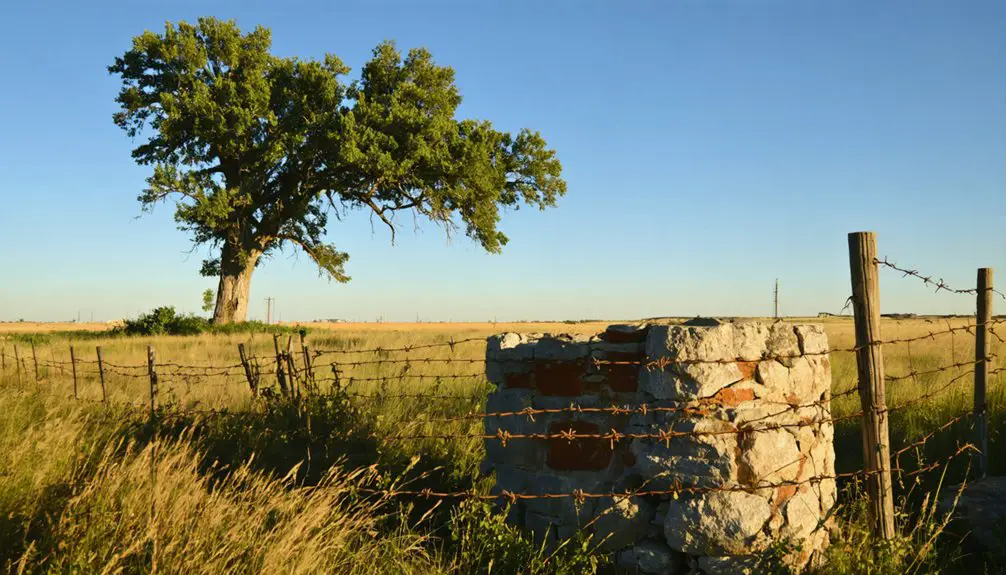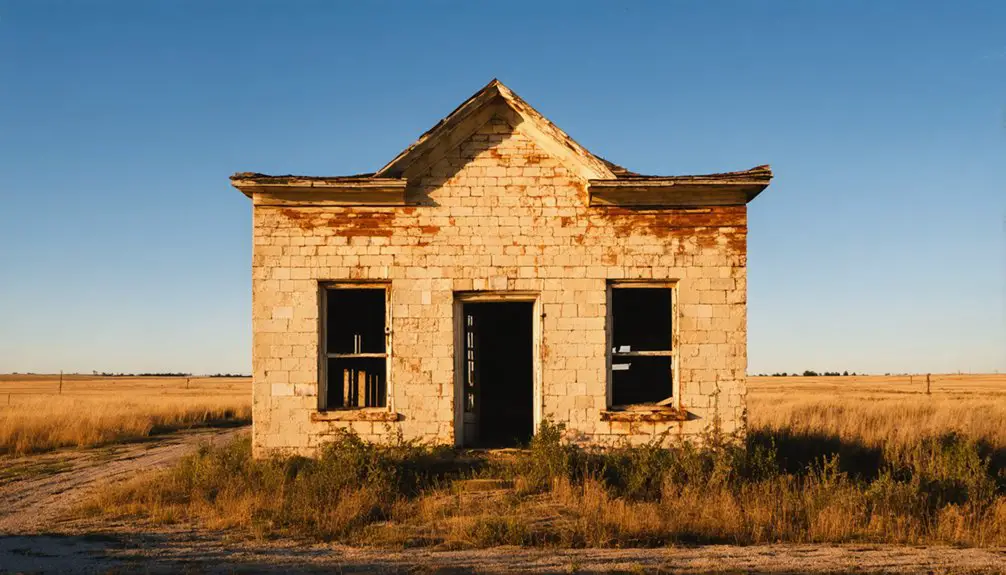You’ll discover Elgin, Kansas as a haunting reminder of the American frontier’s golden age. Founded in 1869, this former cattle shipping powerhouse once bustled with 2,300 residents, featuring brick-paved streets and a thriving railway hub. Today, fewer than 90 people call this ghost town home, where abandoned buildings and an old water tower stand sentinel along the historic main street. The town’s fascinating tales of cattle drives, outlaws, and hidden tunnels await your exploration.
Key Takeaways
- Elgin transformed from a bustling cattle shipping hub of 2,300 residents to a ghost town with only 87 people today.
- The town’s decline began after 1924 due to reduced oil production and cattle trade, culminating in bank closure during 1932.
- Historic structures along brick main street, including abandoned bank building and water tower, stand as deteriorating remnants.
- Originally founded in 1869, Elgin flourished as “Cattle Capital of the World” before economic challenges led to its abandonment.
- The Methodist Church, community building, and Elgin Cemetery remain as maintained landmarks among overgrown vegetation.
The Birth of a Frontier Town
While many frontier towns emerged during America’s westward expansion, Elgin, Kansas began its story in 1869 when entrepreneur Lyman P. Getman established a trading post in the fertile Big Caney River valley.
You’ll find that frontier challenges quickly emerged as the first settlers, including Abraham Lincoln’s cousin Romulus Hanks and his family, discovered their primitive housing wasn’t what they’d expected.
Despite the settlement hardships, you’d have seen the town rapidly take shape. By 1870, Getman opened the Wade & Getman store and became the town’s first postmaster.
Through hardship came growth, as Getman’s store and post office transformed the raw frontier into a bustling settlement.
The arrival of John Lee’s sawmill from Wisconsin marked a turning point, providing essential building materials. The town’s strategic location along the Atchison, Topeka & Santa Fe railway line ensured its growth as a vital transportation hub.
The community’s determination showed as they established the county’s first school, church, and Masonic lodge, transforming this slice of the Kansas-Oklahoma border into a proper frontier settlement. Reverend S. Peacock made history by delivering the first preaching in Chautauqua County.
Railroad Glory Days
When the Atchison, Topeka & Santa Fe Railroad built its massive freight house in Elgin in 1886, you’d hardly recognize the frontier town as it transformed into a bustling railway hub.
Railroad expansion brought unprecedented prosperity, connecting Elgin directly to Chicago, Galveston, and San Francisco. You could witness the world’s greatest cattle shipping operation, where Texas herds arrived in spring and departed for Kansas City in fall. The rate wars between competing railroads drove cattle transport costs down dramatically from $40 to $10 per carload.
The freight transportation network made Elgin the lifeline for Osage Nation towns, with forty wagons running supplies to Pawhuska, Hominy, and beyond. After years of multiple site abandonments, the town finally found its permanent location along the railroad.
A state-of-the-art cattle dipping plant processed two thousand head daily by 1905. The boom years brought paved brick streets, stone buildings, and a thriving business district, though the town’s wild side earned it nicknames like “Shotgun Ridge” and “Hell’s Bend.”
Cattle Drive Legacy
You’ll find Elgin’s prominence as the “Cattle Capital of the World” reflected in its bustling railroad yards, where cowboys once loaded thousands of Texas longhorns onto freight cars bound for eastern markets.
The town’s strategic position along the Chisholm Trail made it a vital shipping hub by 1870, with cattle drives stretching over a mile long and requiring multiple horses per cowboy to manage the massive herds.
Like other infamous cow towns, Elgin’s streets were filled with wild entertainment venues catering to cowboys eager to spend their $520 monthly earnings after long drives.
As you walk through Elgin’s empty streets today, you can almost hear the echoes of thundering hooves and cowboys’ calls from an era when this Kansas town served as the largest southern cattle shipping point in America.
The establishment of a cattle dipping plant in 1905 further solidified Elgin’s dominance in the livestock industry.
Railroad Shipping Hub
During its heyday from the late 1880s through the early 1900s, Elgin, Kansas emerged as the world’s premier cattle shipping hub thanks to the Atchison, Topeka & Santa Fe Railroad’s strategic development. The railroad logistics centered around a massive freight house built in 1886, specifically designed to handle the overwhelming influx of southern and southwestern cattle.
You’ll find the town’s railroad infrastructure was remarkable for its time. Freight transportation involved up to 40-wagon strings moving goods between New Elgin and Osage Nation towns. The rail line connected Chicago, Galveston, and San Francisco, making Elgin an unstoppable force in cattle commerce. The community’s economy thrived on farming and brick manufacturing much like its Texas namesake.
Even more impressive was the world’s first cattle dipping station using Texas crude oil, established in 1905, which could process two thousand cattle daily. This innovation revolutionized livestock health during shipping.
Cowboys and Steers Impact
The rugged cowboys who drove countless herds to Elgin’s rail yards shaped the very soul of this Kansas cattle town. You’d find these trail-hardened men managing herds that stretched over a mile long, each cowboy equipped with ten horses for the grueling journey from Texas.
The spirit of cowboy camaraderie flourished as they guided thousands of cattle to Elgin’s stockyards. Many herds traveled the legendary Western Trail route, which became a vital path through Texas, Indian Territory, and Kansas.
In 1905, cattle health became a top priority when Hayes and Black established the town’s first dipping station. You can imagine the sight of 2,000 cattle being processed on that first day, dunked in Texas crude oil to eliminate disease-carrying ticks.
During Elgin’s peak, you’d witness countless steers grazing the Osage lands before their final rail journey east, a reflection of the town’s reign as the “Cattle Capital of the World.”
Notable Characters and Legends
You’ll find yourself intrigued by Elgin’s most notorious visitors, the Dalton Brothers, who used the bustling cattle town as one of their secret hideouts during its peak shipping days.
The town’s most respected citizen, Rome Hanks, cousin to Abraham Lincoln’s mother Nancy Hanks, served as postmaster, municipal judge, and justice of the peace until his death from pneumonia in 1876 while tending sheep.
These contrasting characters – outlaw and lawman – symbolize Elgin’s fascinating blend of frontier justice and civic development during its brief but vibrant existence. Like many Kansas settlements, the town’s decline began when it experienced a loss of railroads that had once made it a vital shipping point.
Today, with a population of 87, Elgin stands as a testament to its colorful past, preserving stories of both its law-abiding citizens and infamous outlaws.
Dalton Gang’s Secret Hideout
Among the most notorious characters connected to the Dalton Gang‘s secret hideout were Eva Dalton and her husband John N. Whipple, who purchased their Meade home in the late 1880s for $400.
While operating their general store, they’d secretly harbor Eva’s outlaw brothers through an ingenious escape route beneath their property.
You’ll find the Dalton Hideout’s most intriguing feature was its secret tunnel, cleverly built across a rain wash using wooden beams and earth.
This cramped passage, barely wide enough for a man to crawl through, connected the house’s stairwell closet to the barn’s feed room.
After the Whipples lost the property to foreclosure in 1892, the Marshall family discovered the tunnel, reporting mysterious visitors who’d flee upon realizing the Whipples no longer lived there.
Rome Hanks’ Frontier Legacy
Standing prominently among Elgin’s most respected citizens, Rome Hanks left an indelible mark on this Kansas frontier town through his varied roles as postmaster, trading post operator, and justice of the peace.
As Abraham Lincoln’s cousin, Hanks’ contributions extended beyond his distinguished lineage. He embraced the frontier spirit by establishing a successful sheep ranching operation while fostering peaceful relations with local Native Americans who frequented the town.
His community leadership helped shape Elgin during its brief period of prosperity until his untimely death in 1876.
You’ll find his legacy immortalized in Joseph Stanley Pennell’s novel “The History of Rome Hanks and Kindred Matters,” which brought national attention to this Kansas pioneer’s story.
Today, Hanks rests in Elgin Cemetery, overlooking the ghost town he helped build.
Economic Rise and Fall

From humble beginnings in 1869, Elgin, Kansas transformed into a bustling economic powerhouse as one of the world’s largest cattle shipping points along the Atchison, Topeka & Santa Fe Railroad.
By 1890, you’d find a thriving town of 2,300 residents, complete with general stores, saloons, and the county’s first Masonic lodge. The discovery of oil in 1902 sparked another boom, bringing brick-paved streets and modern schoolhouses to the frontier town.
But even the strongest communities face challenges. Despite its remarkable resilience through two economic peaks, Elgin couldn’t withstand the combined pressures of declining oil production and diminishing cattle trade after 1924.
The Great Depression delivered the final blow, forcing the closure of Elgin State Bank in 1932 and triggering an economic decline that would forever alter the town’s destiny.
Life in Early Elgin
Life in early Elgin painted a vibrant portrait of American frontier spirit and community values. In the late 1800s, you’d find a bustling town where education initiatives flourished, starting with the county’s first school and brick churches that anchored the community’s faith.
Early Elgin embodied frontier spirit, with pioneering schools and brick churches shaping a vibrant, growing community.
Shady, brick-paved streets led you past the Masonic lodge and nine saloons where locals gathered for community events.
Here’s what you’d experience in early Elgin:
- First preaching in the county by Rev. S. Peacock, establishing spiritual foundations
- Multiple churches and schools shaping the town’s cultural backbone
- Community gatherings at the Masonic lodge fostering social bonds
- A mix of local businesses, from general stores to professional services, serving daily needs
Architectural Heritage

As one of Kansas’s pioneering settlements, Elgin showcased remarkable architectural diversity through its thoughtfully constructed buildings and distinctive brick-paved streets.
You’ll find evidence of the town’s civic identity in its strategic use of brick and stone construction, from the first schoolhouse to the imposing Masonic lodge that helped define the community’s character.
While many structures haven’t survived Elgin’s economic decline, you can still witness the town’s architectural preservation through its abandoned bank building and historic water tower.
The Olive Lodge No. 350, with its stone facade and artistic interior work by E.C. Puckett, stands as a symbol of the town’s commitment to quality construction.
Margaret’s Café, which operated until 1993, marked the end of an era in Elgin’s rich architectural heritage.
Cultural and Social Landmarks
While Elgin’s physical structures have faded into history, the town’s cultural landmarks tell a rich story of community life and social bonds.
Religious institutions like the Methodist Church and brick churches once anchored the spiritual foundation of this frontier settlement, where Rev. S. Peacock first brought preaching to Chautauqua County.
You’ll find Elgin’s legacy preserved through:
- The first schoolhouse in the county, which drew families and shaped early education
- The pioneering Masonic lodge that fostered social connections
- Margaret’s Café, where photographs and newspapers chronicled local history
- The historic Elgin Cemetery, where stories of prominent citizens like Rome Hanks rest
Community gatherings, from homecoming celebrations to public auctions, kept the town’s spirit alive even as its population dwindled.
Present-Day Remnants

Today’s visitors to Elgin encounter a haunting tableau of deteriorating structures along its brick main street, where empty storefronts and a weathered bank building stand as silent witnesses to the town’s former vibrancy.
The present day decay is evident in the aging homes, where only about 60 residents remain in this once-bustling community. You’ll find the old water tower rising above the ghostly atmosphere, while nature steadily reclaims the landscape with overgrown vegetation and storm-damaged trees.
The Methodist Church and community building remain somewhat maintained, offering glimpses of preserved history. North of town, the well-kept Elgin Cemetery serves as a final tribute to the town’s founders and early settlers, including Romulus Hanks, while defunct railroad lines and crumbling infrastructure mark the passage of time.
Frequently Asked Questions
What Was the Average Price of Land in Elgin During Its Peak?
You’d likely find land values reaching several hundred dollars per acre during 1919-1920’s peak economic conditions, though exact prices weren’t documented amid the oil boom’s prosperity.
How Many Saloons Operated Simultaneously in Elgin During the Railroad Era?
Just like bustling frontier towns Dodge City and Tombstone, nine saloons operated simultaneously during the railroad’s peak era, serving thirsty cowboys and outlaws who’d made their fortune in cattle shipping.
Were There Any Major Fires or Natural Disasters in Elgin’s History?
You won’t find any recorded fire incidents or major disaster impact in the historical records – the town’s eventual decline came from economic changes rather than natural or accidental catastrophes.
What Native American Tribes Primarily Traded or Interacted With Elgin Residents?
You’ll find the Osage tribe dominated trade routes and cultural exchanges with Elgin residents, peacefully gathering in town yards and sharing pasture lands for the bustling cattle industry of the late 1800s.
Did Elgin Have Its Own Newspaper, and How Long Did It Operate?
You’d find the Republican-leaning Elgin Journal operated from 1916 under Thomas E. Trigg’s leadership, serving the community during its oil boom years until likely the mid-1920s when the town’s prosperity declined.
References
- https://legendsofkansas.com/elgin-kansas/
- https://abandonedok.com/elgin-ks./?mode=grid
- https://www.chautauquacountyks.com/city-elgin
- https://abandonedks.com/elgin-ks/
- https://legendsofkansas.com/kansas-ghost-town-list/
- https://abandonedks.com/class/disappearing-towns/
- https://genealogytrails.com/kan/chautauqua/hist_history.html
- http://old.atsfrr.org/resources/burton/sk.htm
- https://www.abandonedrails.com/cedar-vale-branch
- http://www.americancowboychronicles.com/2017/04/kansas-cow-towns-1866-to-1886.html



